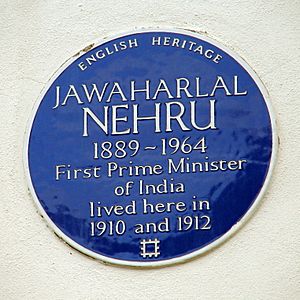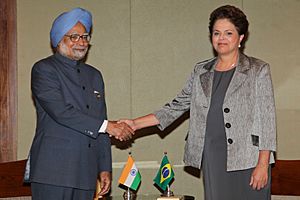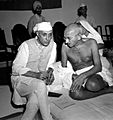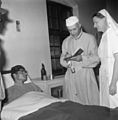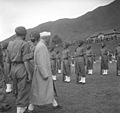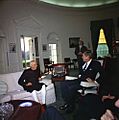Jawaharlal Nehru facts for kids
Quick facts for kids
Pandit
Jawaharlal Nehru
|
|
|---|---|
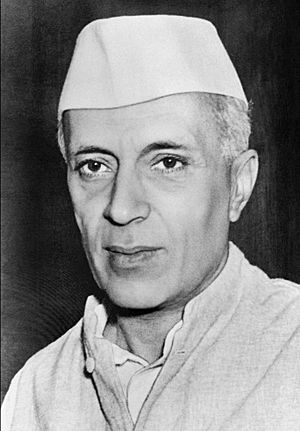
Jawaharlal Nehru in 1947
|
|
| 1st Prime Minister of India | |
| In office 15 August 1947 – 27 May 1964 |
|
| Monarch | George VI (until 26 January 1950) |
| President | Rajendra Prasad Sarvepalli Radhakrishnan |
| Governor General | The Earl Mountbatten of Burma Chakravarti Rajagopalachari (until 26 January 1950) |
| Deputy | Vallabhbhai Patel |
| Preceded by | Position established Himself as Vice President of Executive Council |
| Succeeded by | Gulzarilal Nanda (Acting) |
| Minister of Defence | |
| In office 31 October 1962 – 14 November 1962 |
|
| Preceded by | V. K. Krishna Menon |
| Succeeded by | Yashwantrao Chavan |
| In office 30 January 1957 – 17 April 1957 |
|
| Preceded by | Kailash Nath Katju |
| Succeeded by | V. K. Krishna Menon |
| In office 10 February 1953 – 10 January 1955 |
|
| Preceded by | N. Gopalaswami Ayyangar |
| Succeeded by | Kailash Nath Katju |
| Minister of Finance | |
| In office 13 February 1958 – 13 March 1958 |
|
| Preceded by | Tiruvellore Thattai Krishnamachariar |
| Succeeded by | Morarji Desai |
| In office 24 July 1956 – 30 August 1956 |
|
| Preceded by | Chintaman Dwarakanath Deshmukh |
| Succeeded by | Tiruvellore Thattai Krishnamachariar |
| Minister of External Affairs | |
| In office 2 September 1946 – 27 May 1964 |
|
| Preceded by | Position established |
| Succeeded by | Gulzarilal Nanda |
| Vice President of Executive Council | |
| In office 2 September 1946 – 15 August 1947 |
|
| Personal details | |
| Born | 14 November 1889 Allahabad, United Provinces, British Raj (present-day Uttar Pradesh, India) |
| Died | 27 May 1964 (aged 74) New Delhi, Delhi, India |
| Cause of death | Heart attack |
| Resting place | Shantivan |
| Political party | Indian National Congress |
| Spouse |
Kamala Nehru
(m. 1916; died 1936) |
| Relations | See Nehru–Gandhi family |
| Children | Indira Gandhi |
| Parents | Motilal Nehru Swaruprani Thussu |
| Alma mater | Trinity College, Cambridge Inns of Court |
| Occupation |
|
| Awards | |
| Signature | |
Jawaharlal Nehru (born 14 November 1889 – died 27 May 1964) was the first Prime Minister of India. He was a very important person in Indian politics both before and after India became independent.
Nehru became a top leader in the Indian independence movement. He learned a lot from Mahatma Gandhi. He led India as its Prime Minister from 1947 until he passed away in 1964. Many people see him as the person who helped build modern India. He made India a country that is free, fair, and democratic. People also called him Pandit Nehru. Many Indian children affectionately knew him as Chacha Nehru, which means "Uncle Nehru".
Contents
Early Life and Political Journey
Jawaharlal Nehru was the son of Motilal Nehru, a well-known lawyer and leader. His mother was Swaroop Rani. Nehru studied at Trinity College, Cambridge and became a barrister in England. When he came back to India, he started working at the Allahabad High Court. Soon, he became very interested in politics, which took over from his law career.
Nehru was a strong supporter of Indian independence from a young age. He became a rising star in Indian politics in the 1910s. In the 1920s, he led the younger, more progressive groups within the Indian National Congress. With the support of his mentor, Mahatma Gandhi, he eventually became the leader of the entire Congress party.
In 1929, as the leader of the Congress, Nehru asked for complete independence from the British Raj. This was a big step for the Congress party, moving them towards a more direct fight for freedom. Nehru and the Congress party were very powerful in Indian politics during the 1930s as India moved closer to independence.
Leading Independent India
Under Nehru's leadership, the Congress party was very strong. They won many elections in a row, including in 1951, 1957, and 1962. Even with some challenges later in his life, like the Sino-Indian War in 1962, he remained popular with the people of India. His birthday, 14 November, is celebrated as Bal Diwas (Children's Day) in India.
Nehru faced four known attempts on his life. The first was in 1947 during the partition of India, while he was visiting the North-West Frontier Province. Another attempt happened in 1955 in Maharashtra. A third was in Bombay in 1956. The fourth was a failed bomb attack on train tracks in Maharashtra in 1961. Despite these dangers, Nehru did not like having too much security around him. He also disliked causing traffic jams because of his movements.
Passing Away
Nehru's health started to get worse after 1962. He spent several months resting in Kashmir in 1963. On 26 May 1964, after returning from Dehradun, he felt comfortable and went to bed. The next morning, around 6:30 AM, he felt a pain in his back. He spoke briefly with doctors and then collapsed. He remained unconscious and passed away.
His death was announced to the Lok Sabha (Indian Parliament) at 2:00 PM on 27 May 1964. The cause of death was believed to be a heart attack. Nehru's body was covered in the Indian national flag for public viewing. Many people chanted "Raghupati Raghava Rajaram" as his body was placed on a platform. On 28 May, Nehru was cremated according to Hindu traditions at Shantivan, by the Yamuna river. About 1.5 million people came to Delhi's streets and the cremation grounds to mourn him.
Nehru had such a strong impact on India that his death left the country without a clear leader for a short time. Lal Bahadur Shastri later became the Prime Minister. The news of his death was announced to the Indian parliament with words similar to what Nehru himself said when Gandhi passed away: "The light is out."
Nehru's Impact and Legacy
As India's first Prime Minister and foreign minister, Jawaharlal Nehru played a huge role in shaping modern India. He helped create its government, political ideas, and foreign policy. He is praised for starting a system that provided basic education for all children, even in faraway villages. Nehru's education plans also led to the creation of world-class schools. These include the All India Institute of Medical Sciences, Indian Institutes of Technology, and the Indian Institutes of Management.
Nehru strongly believed in Indian unity. He created programs like the National Book Trust and the National Literary Academy. These programs helped translate books between different Indian languages. They also encouraged sharing cultural materials between regions. Nehru famously warned, "Integrate or perish," meaning India needed to stay united to succeed.
During his life, Jawaharlal Nehru was seen as a hero in India. He was admired worldwide for his ideas and leadership. His birthday, 14 November, is celebrated as Bal Divas ("Children's Day") in India. This is because he cared deeply about the well-being, education, and growth of children and young people. Children across India still remember him as Chacha Nehru (Uncle Nehru).
Nehru remains an important symbol for the Congress Party. They often celebrate his memory. Leaders and members of the Congress party sometimes dress like him, especially wearing the Gandhi cap and the "Nehru jacket". His ideas and policies still influence the Congress Party today. The strong connection to his legacy also helped his daughter, Indira, become a leader of the Congress Party and the country.
Nehru liked to wear the sherwani, which is why it is still considered formal wear in North India. The Nehru jacket is also named after him because he preferred that style. Many public buildings and memorials across India are dedicated to Nehru's memory.
Images for kids
-
Anand Bhawan the Nehru family home in Allahabad
-
Jawaharlal with his parents Swarup Rani Nehru (left) and Motilal Nehru in the 1890s
-
A young Nehru dressed in a cadet's uniform at Harrow School in England
-
Nehru in 1919 with wife Kamala and daughter Indira
-
Nehru in Karachi after returning from Lausanne, Switzerland with the ashes of his wife Kamla Nehru in March 1936
-
Nehru with Indian Nobel-prize-winning poet Rabindranath Tagore in 1936
-
Nehru in a procession at Peshawar, North-West Frontier Province, 14 October 1937
-
Gandhi, Nehru, and Khan Abdul Ghaffar Khan at the Congress Working Committee meeting in Wardha in September 1939
-
Gandhi and Nehru during the drafting of Quit India Resolution in Bombay, August 1942,
-
Nehru and the Congress party members of his interim government after being sworn in by the Viceroy, Lord Wavell, 2 September 1946
-
Lord Mountbatten swears in Nehru as the first Prime Minister of independent India on 15 August 1947
-
Indira Gandhi, Nehru, Rajiv Gandhi and Sanjay Gandhi in June 1949
-
Nehru signing the Indian Constitution c.1950
-
Nehru meeting with Chancellor Konrad Adenauer and Deutsche Bank chairman Hermann Josef Abs during a state visit to West Germany in June 1956.
-
Nehru at an antibiotics manufacturing facility, Poona, 1956
-
Queen Elizabeth II with Nehru and other Commonwealth leaders, taken at the 1960 Commonwealth Conference, Windsor Castle
-
Nehru with Gamal Abdel Nasser and Josip Broz Tito in Belgrade, Yugoslavia, 1961
-
Nehru and Mao Zedong in Beijing, China, October 1954
-
Nehru receiving US President Dwight D. Eisenhower at Parliament House, 1959
-
Nehru on a 1989 USSR commemorative stamp
See also
 In Spanish: Jawaharlal Nehru para niños
In Spanish: Jawaharlal Nehru para niños


